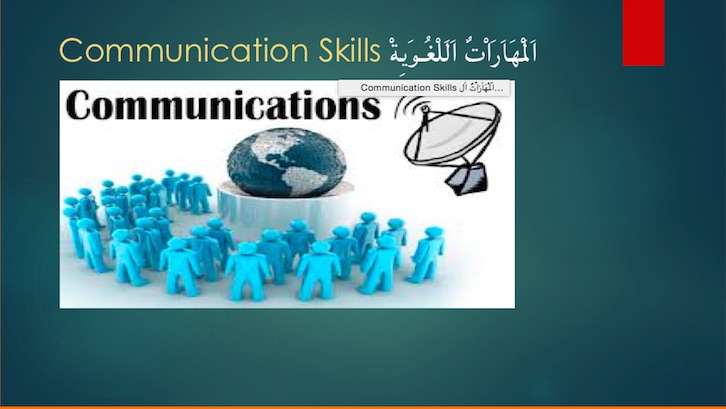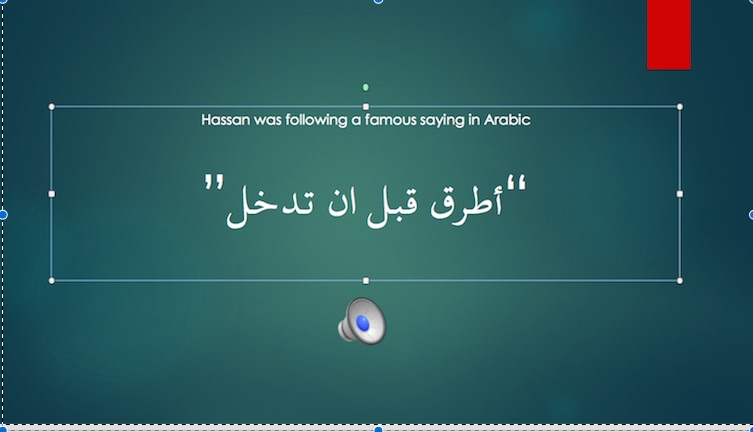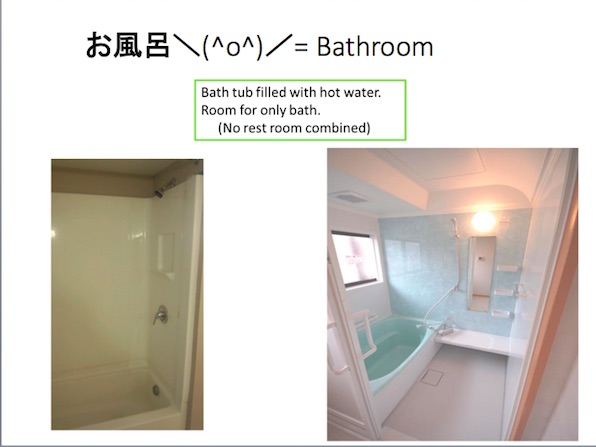Teaching
In a course designed for undergraduate ELLs in their first semester of college study, I taught students how to code-mesh using the strategies Canagarajah presents in his research. As part of the course curriculum, students were required to conduct primary research, specifically to interview a peer from their home countries about how s/he adjusted to life in the United Sates and/or life in a foreign university. Students were asked to present their findings in a multimodal composition such as a video or PowerPoint. They were encouraged to code-mesh when it was appropriate, depending on their audiences and their purposes for composing.
 All the students attempted to code-mesh in their compositions. The biggest challenge for the students was they fell into the habit of simply translating, writing a blurb in English and then writing the text in their native languages right next to the statements in English. Rather than writing in their native languages and providing an audience with context clues to best understand the text, these students failed to move beyond what Hall defines as “ superficial lexical borrowing” (33). To the left is a slide from a student’s PowerPoint in which he discusses the differences of communication skills in the United States and Saudi Arabia. In this slide, he simply writes “communication skills” in English and then translates the phrase in Arabic right next to the English. To code-mesh properly, he needed to create more of a hybrid text, providing his audience with context clues to decipher the Arabic. One such way could be to include the Arabic text and a different picture that visually represented cross-cultural communication skills. Many students fell into this trap of simply translating rather than code-meshing. This finding indicates students struggled with the concept of “entextualization” or using their native languages to create hybrid texts.
All the students attempted to code-mesh in their compositions. The biggest challenge for the students was they fell into the habit of simply translating, writing a blurb in English and then writing the text in their native languages right next to the statements in English. Rather than writing in their native languages and providing an audience with context clues to best understand the text, these students failed to move beyond what Hall defines as “ superficial lexical borrowing” (33). To the left is a slide from a student’s PowerPoint in which he discusses the differences of communication skills in the United States and Saudi Arabia. In this slide, he simply writes “communication skills” in English and then translates the phrase in Arabic right next to the English. To code-mesh properly, he needed to create more of a hybrid text, providing his audience with context clues to decipher the Arabic. One such way could be to include the Arabic text and a different picture that visually represented cross-cultural communication skills. Many students fell into this trap of simply translating rather than code-meshing. This finding indicates students struggled with the concept of “entextualization” or using their native languages to create hybrid texts.
However, there were glimpses of students using code-meshing to effectively communicate with an outside audience who are not native speakers or even familiar with the students’ native languages and cultures. Students effectively employed “envoicing” by including pictures or other visuals in their multimodal compositions. A Saudi Arabian student clearly articulated how code-meshing helped him communicate with an audience, noting, “Because seeing a text or a picture could help explain what I am trying to say. A picture from my culture could explain a lot without me having to use 1000 words [sic] to explain the idea and confuse my audience.” Images from Saudi Arabia helped him convey ideas and communicate with an audience, rather than writing in Standard English to explain a concept in Saudi Arabian culture or Arabic that may not even translate from his L1 into English.
 As the example on the right illustrates, pictures and other images enabled students to best communicate with an audience. Canagarajah defines use of such images rhetorical or code-meshing choices as “envoicing” (50). However, the multimodal nature of the assignment also contributed to the ability to communicate with an audience, as the students were allowed to blend audio and visuals in written texts.
As the example on the right illustrates, pictures and other images enabled students to best communicate with an audience. Canagarajah defines use of such images rhetorical or code-meshing choices as “envoicing” (50). However, the multimodal nature of the assignment also contributed to the ability to communicate with an audience, as the students were allowed to blend audio and visuals in written texts.
Like the Saudi Arabian student, a student from Japan depended on visuals to communicate with an audience. To the left is a slide from a PowerPoint presentation in which a student presented photographs of American and Japanese bathrooms to show a contrast between the two and visually explain how her interviewee struggled to adjust to American dorm life (pictured below on the left), where she was provided with a small, dingy bathroom.
 Here, the student uses images to contrast the restrooms in the United States dorm and her home in Japan. The student also uses written text in English and Japanese. While the written text is simply translated from Japanese into English, using pictures allowed the student to place pieces of her culture and native language into the text and communicate the frustration her interviewee experienced when arriving to an American college. In addition, the student wrote, “An audience didn’t know the thinking or behavior of Japanese people. If they didn’t know it [the culture], they can’t understand my presentation. Code-meshing helped them understand it.” Using visuals presented in the multimodal composition and the Japanese written text, the student communicated with an audience, so the latter could better understand the behaviors of Japanese culture.
Here, the student uses images to contrast the restrooms in the United States dorm and her home in Japan. The student also uses written text in English and Japanese. While the written text is simply translated from Japanese into English, using pictures allowed the student to place pieces of her culture and native language into the text and communicate the frustration her interviewee experienced when arriving to an American college. In addition, the student wrote, “An audience didn’t know the thinking or behavior of Japanese people. If they didn’t know it [the culture], they can’t understand my presentation. Code-meshing helped them understand it.” Using visuals presented in the multimodal composition and the Japanese written text, the student communicated with an audience, so the latter could better understand the behaviors of Japanese culture.
Similarly, the student from Vietnam noted, “If there is a term that I can’t explain, I can use code-meshing to explain it in my native language.” Both the Japanese and Vietnamese students’ responses focus on the importance of effectively communicating with an audience. Indeed, Horner et al. write that students who cannot or do not make use of a translingual approach when writing, limit their abilities to communicate with an audience. Thus solely composing in the dominant discourse actually limits audience participation, inviting only those who speak and/or compose in Standard English to fully participate in the academy. Code-meshing enables students to communicate with audience and present pieces of their cultures to an audience that the latter may not understand at all if the students were required to only compose in Standard English.
Finally, as seen with the example of the restrooms, many students wrote important phrases or concepts in their native languages when presenting their interview findings. For example, a student from Saudi Arabia noted, “I used to translate a phrase in Arabic, which it could have been harder to try and find an English phrase, that has the same meaning.” The student instead used his native language and then paraphrased, using audio in PowerPoint to communicate with an audience. In addition, a student from Japan explained he used Japanese phrases to show the traditional characters of the language. Like the other students described previously, he also used pictures to help depict the culture.
And a student from Taiwan noted that the strategies used to code-mesh helped an audience “learn the culture and its background before judge[ing] everything.” I believe this statement best captures the value of code-meshing. It provides students with a greater platform to share pieces of themselves and their cultures with audience members who have not always valued them or granted them permission to enter into the ongoing conversations that take place within the writing classroom and within the university. Code-meshing helps them find and use their true voices and insert themselves into their writing.